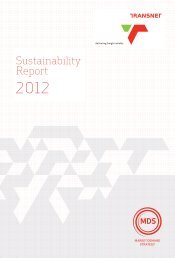Chapter 8 - Conclusion - Transnet
Chapter 8 - Conclusion - Transnet
Chapter 8 - Conclusion - Transnet
You also want an ePaper? Increase the reach of your titles
YUMPU automatically turns print PDFs into web optimized ePapers that Google loves.
<strong>Transnet</strong> LimitedPhase 2 Expansion: Port of SaldanhaEnvironmental Scoping Report• Visual impact: the existing iron ore handling facility is a highly visibleelement owing to the 4km pier protruding into the bay, the industrialinfrastructure and the large carrier ships docked in the harbouroccasionally. It is not clear how these visual impacts can be mitigated.Therefore, this aspect must be considered in a full visual impactassessment.• Shipping traffic as a result of the increase in average ship size and theexpected increase in the number of ships that would visit the port inorder to realize the export target. Mitigation measures focussing onballast water management and shipping risks should be developedduring the EIA phase.• Traffic impact due to the fact that surrounding access roads will beaffected by the rail component of the expansion. A full traffic impactstudy must be undertaken.• Impact on heritage / historical resources. This is an impact that oftenarises during construction, the significance of which can only be fullydetermined after a detailed assessment has been undertaken.• Impacts related to the social environment e.g. the BlouwaterbaaiCommunity. The socio-economic impact assessment must providesuggestions and recommendations to address all the major concernsand issues of I&APs.• Location of suitable marine dump sites to dispose of dredge spoil. Thisissue should be investigated extensively. The study on the marine dumpsites must focus on identifying and characterising suitable dump sites,based on the nature of the dredge material.8.2 ALTERNATIVES TO BE ASSESSED IN THE IMPACT ASSESSMENT PHASEScoping included preliminary specialist studies that enabled the identification ofimpacts and key issues. A holistic approach based on the principles of IEM was usedto integrate and weigh the likely impacts of building the handling facility at the currentSaldanha port. This was done by mapping all the layout alternatives and possibleimpact points at the current port. Other project alternatives must be identified andassessed in the EIA phase.A purely technical scoping of the biophysical and socio-economic issues or potentialimpacts is to be followed by a detailed assessment of the impacts. This assessmentwill be undertaken in terms of the issues or guidelines identified in Section 6.98Prepared by the PDNA/SRK Joint Venture
<strong>Transnet</strong> LimitedPhase 2 Expansion: Port of SaldanhaEnvironmental Scoping Report8.2.1 Issues and Concerns Raised by I&AP’sVarious issues have been raised over the years as a result of the current operationsof the port. These issues will need to be thoroughly addressed and accommodatedwhen the choice of the preferred site layout for the iron ore expansion facility ischosen.8.3 CONCLUSIONThe expansion of the iron ore handling facility is a major development project ofnational significance, which is proposed in a sensitive environment, where severalenvironmental issues are at stake. As such, the project could have many negativeimpacts on the biophysical and social environments. However, if duly planned andimplemented the project could also enhance the economic potential of Saldanha Bay,Langebaan Vredenburg and their environs, while impacting minimally on theenvironment. Several of the likely impacts of the development are identified here.None of these impacts appear impossible to mitigate and manage. Nevertheless, adetailed EIA is required to recommend specific mitigation measures for thedevelopment and to identify the relative impacts of each alternative. The EIA shouldfocus on the site layout alternatives.Based on the public participation process outlined in Section 5 of this report theactivities described in Table 10 are scheduled to take place in order to complete theScoping exercise and proceed to the EIA.Table 10: Anticipated timeframes for the completion of the EIA processActivityDateStartEndSCOPING PHASENotification of the start of the review process for the 15 January 2007 19 January 2007Draft Scoping Report sent to all authorities andregistered I&AP’sPublic Review of Draft Scoping Report 22 January 2007 23 February 2007Submission of Final Scoping Report and Plan of 9 March 2007 9 March 2007Study for EIA to the Authorities (DEAT andDEA&DP)EIA PHASEAll specialist studies In Progress Tentative date ofcompletion June2007Release of Draft EIA Report to I&AP’s (with 10 September 2007 26 October 2007Preliminary specialist findings)Public Open Days 1 October 2007 5 October 2007Submission of Final EIA and EMP to the Authorities 21 December 2007 24 December 200799Prepared by the PDNA/SRK Joint Venture
















